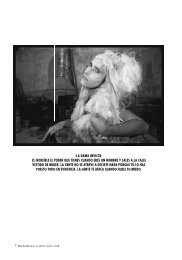MUSEUM, URBAN DETRITUS AND PORNOGRAPHY - Arteleku
MUSEUM, URBAN DETRITUS AND PORNOGRAPHY - Arteleku
MUSEUM, URBAN DETRITUS AND PORNOGRAPHY - Arteleku
You also want an ePaper? Increase the reach of your titles
YUMPU automatically turns print PDFs into web optimized ePapers that Google loves.
Museum, urban detritus and pornography ]Beatriz Preciado<br />
those which are intrinsically and naturally<br />
masculine. Instead, culturally and historically,<br />
women have been kept away from audiovisual<br />
masturbatory techniques —this<br />
distancing is comparable to the exclusion<br />
of women from the Secret Museum, from<br />
the street and the sex trade, and the result<br />
was that until the mid twentieth century, the<br />
public space was constructed as a white<br />
male space. The restriction of the sphere of<br />
reception of pornography in terms of gender<br />
led to an interesting paradox: the creation<br />
of a homoerotic context of reception 13 . Projection<br />
of pornographic images in a space<br />
from which women are excluded inevitably<br />
tends to sexualise relations between<br />
straight men.<br />
The invention of the photograph as imagemovement<br />
formed part of a series of techniques<br />
that produced a distinction between<br />
the normal and the pathological. It is impossible<br />
to disassociate the history of early<br />
pornographic performances from the history<br />
of medical «freak» photographs, photos<br />
of deformed and crippled bodies and colonial<br />
photography. It is important to remember<br />
that the invention of photography and<br />
cinema marked a key point in the transition<br />
and formation of modern sexual/political rationality.<br />
This was the moment when sexual<br />
identities such as heterosexual, homosexual,<br />
hysterical, fetishist and sadomasochist<br />
were invented as visual and depictable typologies.<br />
If medical representation sought<br />
to make the body confess, through the image,<br />
the truth of sex, pornography sought<br />
to make pleasure (and its pathologies) visible.<br />
In this context, Linda Williams sees<br />
pornography as a technique of involuntary<br />
confession: the production of a knowledge<br />
of the subject, telling the sexual truth about<br />
the subject.<br />
In cinematographic terms, the pornographic<br />
image belongs to the set of images that depict<br />
the body in motion. The visual pleasure<br />
proceeds from what fi lm theoreticians call<br />
a synaesthetic translation, in other words<br />
a transferral from the sense of touch to the<br />
sense of sight. Moreover, pornography belongs<br />
to the class of moving pictures that<br />
cause an involuntary reaction in the viewer's<br />
body. This is what Linda Williams calls a<br />
«body image», an image that moves the body<br />
and its feelings: in the case of pornography,<br />
the image turns back on the spectator's<br />
body, causing involuntary effects which he<br />
or she cannot control. We might say that the<br />
characteristic feature of pornography (as<br />
of other genres such as comedy and horror)<br />
is that the visual intentionality is not so<br />
much projective, as introjective, not directive<br />
so much as reactive. In other words, in<br />
pornography the body is vulnerable to the<br />
image. This feature complicates Dworkin or<br />
Mackinon's one-way interpretation (partly<br />
in line with the hypotheses Laura Mulvey<br />
makes in her analysis of fi lm representation<br />
in her classic Visual Pleasure and Narrative<br />
Cinema ): if Mackinnon and Dworkin<br />
consider patriarchal and male power as a<br />
factor in structuring the visual semiotic of<br />
pornography which turns the female body<br />
into an object of visual pleasure, they fail to<br />
explain the paradoxical position of the male<br />
spectator who chooses to allow himself be<br />
dominated by the pornographic image 14 .<br />
Post-pornography will be no more than a<br />
name used to describe different strategies<br />
of critique and intervention in representation<br />
arising out of the reaction of feminist,<br />
homosexual and queer revolutions to these<br />
three pornographic regimes (the museum,<br />
the urban and the cinematographic) and to<br />
the modern sexual/political techniques of<br />
controlling the body and producing pleasure,<br />
of dividing private and public spaces<br />
and accessing the visibility they deploy.<br />
Jean Genet, Andy Warhol, Kenneth Anger,<br />
Veronica Vera, Annie Sprinkle... the notion<br />
of post-pornography suggests an epistemological<br />
and political break, another way of<br />
knowing and producing pleasure through<br />
looking, but also a new definition of the<br />
public space and new ways of inhabiting<br />
the city.<br />
36



